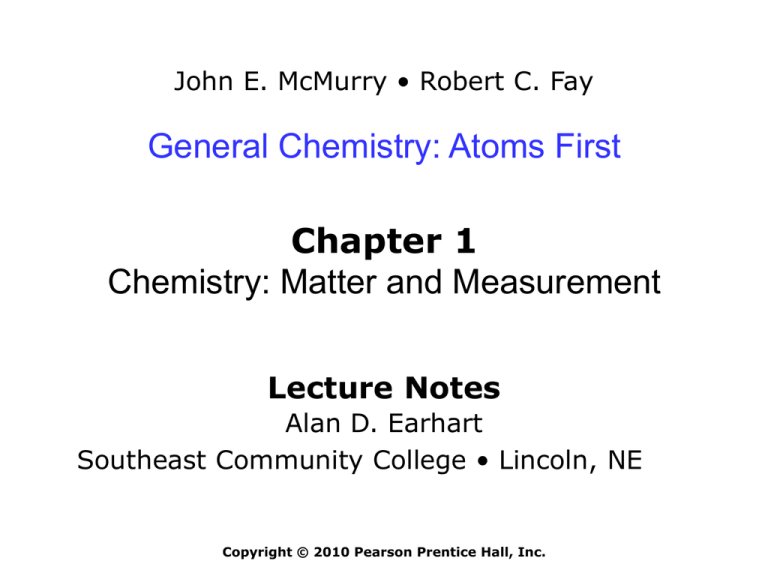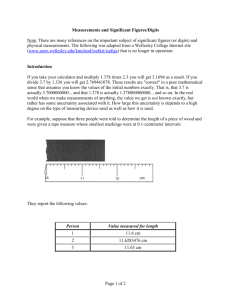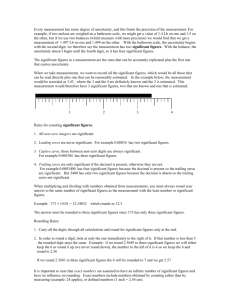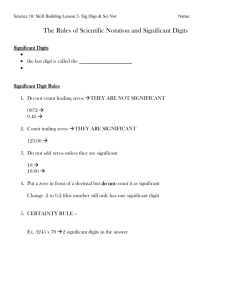
John E. McMurry • Robert C. Fay
General Chemistry: Atoms First
Chapter 1
Chemistry: Matter and Measurement
Lecture Notes
Alan D. Earhart
Southeast Community College • Lincoln, NE
Copyright © 2010 Pearson Prentice Hall, Inc.
Chemistry and the Elements
Chapter 1/2
The Periodic Table
• Professor Dmitri Mendeleev published the
first Periodic Table of the Atomic Elements in
1869 based on properties which appeared
with some regularity as he laid out the
elements from lightest to heaviest. [1]
• When Mendeleev proposed his periodic
table, he noted gaps in the table, and
predicted that unknown elements existed with
appropriate properties to fill those gaps.
Chapter 1/3
Elements and the Periodic
Table
Mendeleev’s Periodic Table (1871)
For the unknown elements, Mendeleev used the prefixes eka-, dvi-, and
tri-, from the Sanskrit words for one, two, and three, depending upon
whether the predicted element was one, two, or three places down from
the known element in his table with similar chemical properties.
Chapter 1/4
Elements and the Periodic
Table
Chapter 1/5
Chapter 1/6
Elements and the Periodic
Table
Main Groups
• columns 1A–2A (2 groups)
• columns 3A–8A (6 groups)
Transition Metals: 3B–2B (8 groups, 10 columns)
Inner Transition Metals: 14 groups between 3B and 4B
• lanthanides
• actinides
Chapter 1/7
Some Chemical Properties of
the Elements
Property: Any characteristic that can be used to
describe or identify matter.
Intensive Properties: Do not depend on sample size.
• temperature
• melting point
Extensive Properties: Do depend on sample size.
• length
• Volume
• mass
Chapter 1/8
Some Chemical Properties of
the Elements
Physical Properties: Characteristics that do not
involve a change in a sample’s chemical makeup.
Chemical Properties: Characteristics that do
involve a change in a sample’s chemical makeup.
Chapter 1/9
Some Chemical Properties of
the Elements
Alkali Metals
Chapter 1/10
Some Chemical Properties of
the Elements
Alkali Metals
• lithium (Li), sodium (Na), potassium (K)
, rubidium (Rb),caesium (Cs), and
francium (Fr).
• The alkali metals provide one of the
best examples of group trends in
properties in the periodic table, with well
characterized homologous behavior
down the group.
• Hydrogen, although a member of Group
1, very rarely exhibits alkali metal
behavior. Exists as diatomic species.
• all highly reactive and are never found
in elemental forms in nature.
Chapter 1/11
Some Chemical Properties of
the Elements
Alkaline Earth Metals
Chapter 1/12
Some Chemical Properties of
the Elements
Alkaline Earth Metals
•beryllium (Be), magnesium (Mg
), calcium(Ca), strontium (Sr),
barium (Ba) and radium (Ra).
• their oxides that give basic
alkaline solutions.
• silver colored, soft metals,
which react readily with
halogens to form ionic salts,
and with water, though not as
rapidly as the alkali metals, to
form strong basic hydroxides.
Chapter 1/13
Some Chemical Properties of
the Elements
Halogens
Chapter 1/14
Some Chemical Properties of
the Elements
Halogens
• fluorine (F),chlorine (Cl),
bromine (Br), iodine (I),
and astatine (At).
• highly reactive
• found in the environment only
in compounds or as ions.
• the halogens exist as diatomic
molecules
Chapter 1/15
Some Chemical Properties of
the Elements
Noble Gases
Chapter 1/16
Some Chemical Properties of
the Elements
Noble Gases
• helium (He), neon (Ne), argon
(Ar), krypton (Kr), xenon (Xe), and
the radioactive radon (Rn).
•odorless,colorless, monatomic
gases, with very low chemical
reactivity.
Chapter 1/17
Some Chemical Properties of
the Elements
Metals
Chapter 1/18
Some Chemical Properties of
the Elements
Metals
A metal is a chemical
element that is a
good conductor of
both electricity and heat
and forms cations
and ionic bonds with
non-metals.
Some Chemical Properties of
the Elements
Nonmetals
Chapter 1/20
Some Chemical Properties of
the Elements
Nonmetals
• no rigorous definition for the
term "nonmetal“
• poor conductors of heat
and electricity
• form acidic oxides vs. metals
forming basic oxides.
• dull, brittle solids with low
densities.
• high electronegativity
Chapter 1/21
Some Chemical Properties of
the Elements
Semimetals – Metalloids
Boron (B)
Silicon (Si)
Germanium (Ge)
Arsenic (As)
Antimony (Sb)
Tellurium (Te)
Polonium (Po)
insulators
Chapter 1/22
Experimentation & Measurement
The Scientist’s Tools of the Trade
Chapter 1/23
What Is a Measurement?
• a quantitative
observation
• Comparison against
an agreed-upon
standard
• every measurement
has a number and a
unit
24
Experimentation & Measurement:
Units
Système Internationale d´Unités
All other units are derived from these fundamental units.
Chapter 1/25
Units
This point is critical!
• Always write every number with its
associated unit
– Always include units in your calculations
– By not following this simple rule, you will
get a wrong answer more often than the
correct one.
• Smart people go from the A-list to the D-list by
ignoring units!!!!!!!!!!
– using units as a guide to problem solving is
called dimensional analysis
26
Mass and Its Measurement
Matter: Describes anything with a physical presence—
anything you can touch, taste, or smell. Any physical
object whether solid, liquid, or gas, that occupies
space
Mass: Amount of matter in an object. The quantity of
matter as determined from its weight
Weight: Measures the force with which gravity pulls on
an object (mass).
Chapter 1/28
Mass and Its Measurement
Chapter 1/29
30
31
Length and Its Measurement
The Meter
•
1790: One ten-millionth of the distance
from the equator to the North pole along a
meridian running through Paris, France.
•
1889: Distance between two thin lines on a
bar of platinum-iridium alloy stored near
Paris, France.
•
1983: The distance light travels in
1/299,792,458 of a second.
Chapter 1/32
Temperature
• measure of the average amount of kinetic energy
– higher temperature = larger average kinetic energy
• heat flows from matter with high thermal energy into
matter having low thermal energy
– until they reach the same temperature
– heat is exchanged through molecular collisions between
the two materials
Temperature and Its
Measurement
• Fahrenheit Scale, °F
°F =
9 °F
°C + 32 °F
5 °C
°C =
5 °C
(°F - 32 °F)
9 °F
– used in the U.S.
• Celsius Scale, °C
– used in all other
countries
• Kelvin Scale, K
– absolute scale
• no negative numbers
K = °C + 273.15
– directly proportional to
average amount of
kinetic energy
– 0 K = absolute zero
Chapter 1/34
Derived Units:
Volume and Its Measurement
Chapter 1/36
Chapter 1/37
Measuring Liquid Volume
Derived Units:
Density and Its Measurement
Density =
Mass (g)
Volume (mL or cm3)
Chapter 1/39
Derived Units:
Energy and Its Measurement
Energy: Capacity to supply heat or do work.
Kinetic Energy (EK): The energy or motion.
Potential Energy (EP): Stored energy.
Units:
1 calorie (cal) = 4.184 J (joule)
1 Cal = 1000 cal = 1 kcal = 4.184 J
Chapter 1/40
Accuracy, Precision, and
Significant Figures
Accuracy: How close to the true value a given
measurement is.
• Single measurement: percent error
• Series of measurements: average
Precision: How well a number of independent
measurements agree with each other. This can be
characterized by the standard deviation.
Chapter 1/41
Accuracy, Precision, and
Significant Figures
Mass of a Tennis Ball
Measurement
#
Bathroom
Scale
Lab
Balance
Analytical
Balance
1
0.0 kg
54.4 g
54.4418 g
2
0.0 kg
54.5 g
54.4417 g
3
0.1 kg
54.3 g
54.4418 g
(average)
(0.03 kg)
(54.4 g)
(54.4418 g)
Chapter 1/42
Accuracy, Precision, and
Significant Figures
Mass of a Tennis Ball
Measurement
#
Bathroom
Scale
Lab
Balance
Analytical
Balance
1
0.0 kg
54.4 g
54.4418 g
2
0.0 kg
54.5 g
54.4417 g
3
0.1 kg
54.3 g
54.4418 g
(average)
(0.03 kg)
(54.4 g)
(54.4418 g)
good accuracy
good precision
Chapter 1/43
Accuracy, Precision, and
Significant Figures
Mass of a Tennis Ball
Measurement
#
Bathroom
Scale
Lab
Balance
Analytical
Balance
1
0.0 kg
54.4 g
54.4418 g
2
0.0 kg
54.5 g
54.4417 g
3
0.1 kg
54.3 g
54.4418 g
(average)
(0.03 kg)
(54.4 g)
(54.4418 g)
good accuracy
poor precision
Chapter 1/44
Accuracy, Precision, and
Significant Figures
Mass of a Tennis Ball
Measurement
#
Bathroom
Scale
Lab
Balance
Analytical
Balance
1
0.0 kg
54.4 g
54.4418 g
2
0.0 kg
54.5 g
54.4417 g
3
0.1 kg
54.3 g
54.4418 g
(average)
(0.03 kg)
(54.4 g)
(54.4418 g)
poor accuracy
poor precision
Chapter 1/45
Accuracy vs. Precision
46
Accuracy, Precision, and
Significant Figures
Significant figures: The total number of digits
recorded in a measured or calculated quantity.
They come from uncertainty in any measurement.
Generally the last digit in a reported measurement
is uncertain (estimated).
Exact numbers and relationships (7 days in a
week, 30 students in a class, etc.) effectively have
an infinite number of significant figures.
Chapter 1/47
Accuracy, Precision, and
Significant Figures
cm
0
1
2
3
4
1.7 cm < length < 1.8 cm
length = 1.74 cm
Chapter 1/48
Accuracy, Precision, and
Significant Figures
Rules for counting significant figures (left-to-right):
1. Zeros in the middle of a number are like any other
digit; they are always significant.
4.803 cm
4 SF
Chapter 1/49
Accuracy, Precision, and
Significant Figures
Rules for counting significant figures (left-to-right):
1. Zeros in the middle of a number are like any other
digit; they are always significant.
2. Zeros at the beginning of a number are not
significant; they act only to locate the decimal point.
0.006 61 g
3 SF
(or 6.61 x 10-3 g)
Chapter 1/50
Accuracy, Precision, and
Significant Figures
Rules for counting significant figures (left-to-right):
1. Zeros in the middle of a number are like any other
digit; they are always significant.
2. Zeros at the beginning of a number are not
significant; they act only to locate the decimal point.
3. Zeros at the end of a number and after the decimal
point are always significant.
55.220 K
5 SF
Chapter 1/51
Accuracy, Precision, and
Significant Figures
4) Trailing zeros may or may not be significant
•
Trailing zeros after a decimal point are significant
1.050 has 4 sig. figs.
•
Zeros at the end of a number without a written
decimal point are ambiguous and should be
avoided by using scientific notation
If 150 has 2 sig. figs. then it is written 1.5 x 102
If 150 has 3 sig. figs. then it is written 1.50 x 102
Should be written 150. to have 3 sig. figs.
Chapter 1/52
Rounding Numbers
Math rules for keeping track of significant figures:
•
Multiplication or division: The answer can’t have
more significant figures than any of the original
numbers.
3 SF
4 SF
278 mi
= 23.8 mi/gal (mpg)
11.70 gal
3 SF
Chapter 1/53
Rounding Numbers
Math rules for keeping track of significant figures:
•
Addition or subtraction: The answer can’t have
more digits to the right of the decimal point than any
of the original numbers.
2 decimal places
3.18
+ 0.01315
3.19
5 decimal places
2 decimal places
Chapter 1/54
Rounding Numbers
Rules for rounding off numbers:
1. If the first digit you remove is less than 5, round
down by dropping it and all following digits.
5.664525 = 5.66
Chapter 1/55
Rounding Numbers
Rules for rounding off numbers:
1. If the first digit you remove is less than 5, round
down by dropping it and all following digits.
2. If the first digit you remove is 6 or greater, round up
by adding 1 to the digit on the left.
5.664525 = 5.7
Chapter 1/56
Rounding Numbers
Rules for rounding off numbers:
1. If the first digit you remove is less than 5, round
down by dropping it and all following digits.
2. If the first digit you remove is 6 or greater, round up
by adding 1 to the digit on the left.
3. If the first digit you remove is 5 and there are more
nonzero digits following, round up.
5.664525 = 5.665
Chapter 1/57
Rounding Numbers
Rules for rounding off numbers:
1. If the first digit you remove is less than 5, round
down by dropping it and all following digits.
2. If the first digit you remove is 6 or greater, round up
by adding 1 to the digit on the left.
3. If the first digit you remove is 5 and there are more
nonzero digits following, round up.
4. If the digit you remove is a 5 with nothing following,
round down.
5.664525 = 5.66452
Chapter 1/58
Calculations: Converting from
One Unit to Another
Dimensional analysis: A method that uses a conversion
factor to convert a quantity expressed with one unit to an
equivalent quantity with a different unit.
Conversion factor: States the relationship between two
different units.
original quantity x conversion factor = equivalent
quantity
Arrange conversion factors so given units cancel
Arrange conversion factor so given unit is on the
bottom of the conversion factor
Chapter 1/59
Calculations: Converting from
One Unit to Another
Many problems in chemistry involve using relationships
to convert one unit of measurement to another
Relationship:
Conversion factor:
or
1 m = 39.37 in
1m
39.37 in
Used to convert
measurement given in
inches to meters
39.37 in
1m
Used to convert
measurement given in
Meters to inches
Chapter 1/60
Calculations: Converting from
One Unit to Another
Incorrect Method
69.5 in x 39.37 in = 2740 in2/m
1m
starting quantity
??
conversion factor
Chapter 1/61
Calculations: Converting from
One Unit to Another
Correct Method
69.5 in x
starting quantity
1m
= 1.77 m
39.37 in
equivalent quantity
conversion factor
Chapter 1/62








